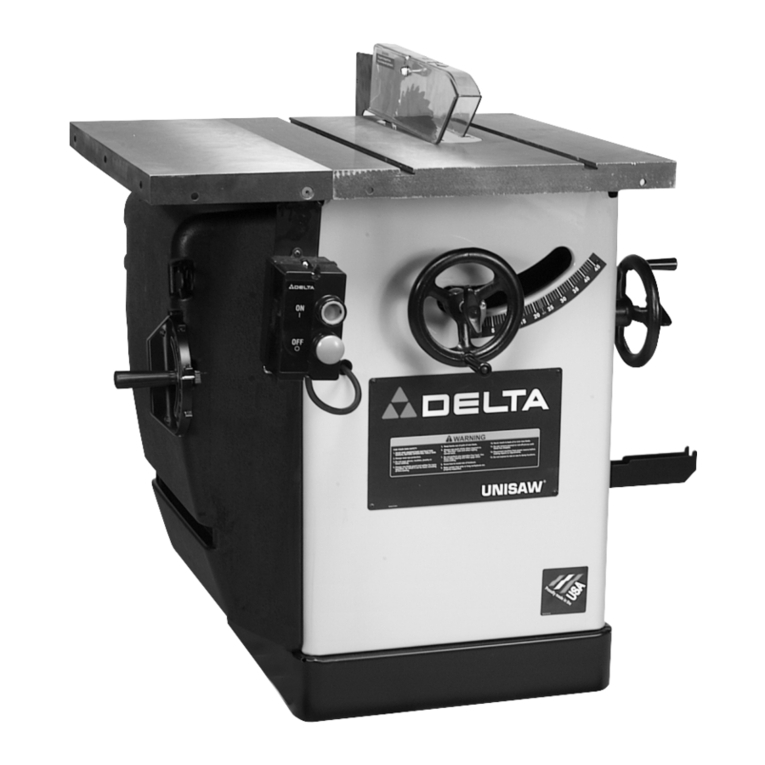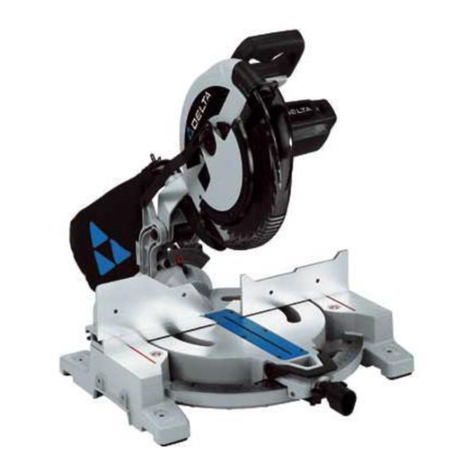Delta ShopMaster BS150LS User manual

10"BandSaw
Scie_rubande
254mm(10po)
Sierradebanda
54mm(10po)
A15113-01-13-06Rev.A
Copyright© 2006DeltaMachinery
InstructionManual
Manueld'Utilisation
ManualdeInstrucciones
www.deltamachinery.com
(800)223-7278-US
(800)463-3582-CANADA

IMPORTANT SAFETY INSTRUCTIONS ........................................................... 2
SAFETY GUIDELINES =DEFiNITiONS ........................................................... 3
GENERAL SAFETY RULES .................................................................... 4
ADDITIONAL SPECIFIC SAFETY RULES ......................................................... 5
FUNCTIONAL DESCRIPTION .................................................................. 7
CARTON CONTENTS ......................................................................... 7
ASSEMBLY ................................................................................. 8
OPERATION ............................................................................... 12
TROUBLESHOOTING GUIDE .................................................................. 20
TROUBLESHOOTING ........................................................................ 22
MAINTENANCE ............................................................................. 23
SERVICE .................................................................................. 23
ACCESSORIES ............................................................................. 23
WARRANTY ................................................................................ 24
FRAN_AIS ................................................................................. 25
ESPA_IOL .................................................................................. 47
Read and understand all warnings and operating instructions before using any tool or equipment.
When using tools or equipment, basic safety precautions should always be followed to reduce the risk of
personal injury. Improper operation, maintenance or modification of tools or equipment could result in serious
injury and property damage. There are certain applications for which tools and equipment are designed. Delta
Machinery strongly recommends that this product NOT be modified and/or used for any application other than
for which it was designed.
if you have any questions relative to its application DO NOT use the product until you have written Delta Machinery
and we have advised you.
Online contact form at www.deltamachinery.com
Postal Mail: Technical Service Manager
Delta Machinery
4825 Highway 45 North
Jackson, TN 38305
(IN CANADA: 125 Mural St. Suite 300, Richmond Hill, ON, L4B 1M4)
Information regarding the safe and proper operation of this tool isavailable from the following sources:
Power Tool Institute
1300 Sumner Avenue, Cleveland, OH 44115-2851
www.powertoolinstitute.org
National Safety Council
1121 Spring Lake Drive, Itasca, IL 60143-3201
American National Standards Institute, 25 West 43rd Street, 4 floor, New York, NY 10036 www.ansi.org
ANSi 01.1Safety Requirements for Woodworking Machines, and the U.S. Department of Labor regulations www.osha.g£y
SAVE THESE INSTRUCTIONS!

it is important for you to read and understand this manual. The information it contains relates to __,dL
protecting YOUR SAFETY and PREVENTING PROBLEMS. The symbols below are used to help you _Q_
recognize this information.
indicates an imminently hazardous situation which, if not avoided, will result in death or
_ serious injury.
Indicates a potentially hazardous situation which, if not avoided, could result in death or serious
-- injury.
indicates a potentially hazardous situation which, if not avoided, may result in minor or moderate
-- injury.
Used without the safety alert symbol indicates potentially hazardous situation which, if not
-- avoided, may result in property damage.
CALiFORNiA PROPOSiTiON 65
SOME DUST CREATED BY POWER SANDING, SAWING, GRINDING, DRILLING, AND OTHER CONSTRUCTION
ACTIVITIES contains chemicals known to cause cancer, birth defects or other reproductive harm. Some examples of
these chemicals are:
•lead from lead-based paints,
•crystalline silica from bricks and cement and other masonry products, and
• arsenic and chromium from chemically-treated lumber•
Your risk from these exposures varies, depending on how often you do this type of work. To reduce your exposure to
these chemicals: work in a well ventilated area, and work with approved safety equipment, always wear NIOSH/OSHA
approved, properly fitting face mask or respirator when using such tools.

Failure to follow these rules may result in serious personal injury.
1. FOR YOUR OWN SAFETY, READ THE INSTRUCTION
MANUAL BEFORE OPERATING THE MACHINE. Learning
the machine's application, limitations, and specific hazards
will greatly minimize the possibility of accidents and injury.
2. WEAR EYE AND HEARING PROTECTION. ALWAYS
USE SAFETY GLASSES. Everyday eyeglasses are NOT
safety glasses. USE CERTIFIED SAFETY EQUIPMENT.
Eye protection equipment should comply with ANSI Z87.1
standards. Hearing equipment should comply with ANSI
$3.19 standards.
3. WEAR PROPER APPAREL, Do not wear loose clothing,
gloves, neckties, rings, bracelets, or other jewelry which may
get caught in moving parts. Nonslip protective footwear is
recommended. Wear protective hair covering to contain long
hair.
4. DO NOT USE THE MACHINE IN A DANGEROUS
ENVIRONMENT. The use of power tools in damp or wet
locations or in rain can cause shock or electrocution. Keep
your work area well-lit to prevent tripping or placing arms,
hands, and fingers in danger.
5. MAINTAIN ALL TOOLS AND MACHINES IN PEAK
CONDiTiON, Keep tools sharp and clean for best and safest
performance. Follow instructions for lubricating and changing
accessories. Poorly maintained tools and machines can further
damage the tool or machine and/or cause injury.
6. CHECK FOR DAMAGED PARTS. Before using the machine,
check for any damaged parts. Check for alignment of moving
parts, binding of moving parts, breakage of parts, and any
other conditions that may affect its operation. A guard or any
other part that is damaged should be properly repaired or
replaced with Delta or factory authorized replacement
parts. Damaged parts can cause further damage to the
machine and/or injury.
7. KEEP THE WORK AREA CLEAN. Cluttered areas and benches
inviteaccidents.
8. KEEP CHILDREN AND VISITORS AWAY. Your shop is a
potentially dangerous environment. Children and visitors can be
injured.
9. REDUCE THE RISK OF UNINTENTIONAL STARTING. Make
sure that the switch is in the "OFF" position before plugging
in the power cord. In the event of a power failure, move the
switch to the "OFF" position. An accidental start-up can cause
injury. Do not touch the plug's metal prongs when unplugging
or plugging in the cord.
10. USE THE GUARDS. Check to see that all guards are inplace,
secured, and working correctly to prevent injury.
11. REMOVE ADJUSTING KEYS AND WRENCHES BEFORE
STARTING THE MACHINE. Tools, scrap pieces, and other
debris can be thrown at high speed, causing injury.
12. USE THE RIGHT MACHINE. Don't force a machine or an
attachment to do ajob for which it was not designed. Damage
to the machine and/or injury may result.
13. USE RECOMMENDED ACCESSORIES. The use of
accessories and attachments not recommended by Delta
may cause damage to the machine or injury to the user.
14. USE THE PROPER EXTENSION CORD. Make sure your
extension cord is in good condition. When using an extension
cord, be sure to use one heaw enough to carry the current
your product will draw. An undersized cord will cause a drop
in line voltage, resulting in loss of power and overheating. See
the Extension Cord Chart for the correct size depending on
the cord length and nameplate ampere rating. If in doubt, use
the next heavier gauge. The smaller the gauge number, the
heavier the cord.
15. SECURE THE WORKPIECE. Use clamps or a vise to hold the
workpiece when practical. Loss of control of aworkpiece can
cause injury.
16. FEED THE WORKPIECE AGAINST THE DiRECTiON OF
THE ROTATION OF THE BLADE, CUTTER, OR ABRASIVE
SURFACE. Feeding it from the other direction will cause the
workpiece to be thrown out at high speed.
17. DON'T FORCE THE WORKPIECE ON THE MACHINE.
Damage to the machine and/or injury may result.
18. DON'T OVERREACH. Loss of balance can make you fall into
a working machine, causing injury.
19. NEVERSTAND ON THE MACHINE. Injurycould occur ifthe tool
tips,or ifyou accidentally contact the cuttingtool.
20. NEVER LEAVE THE MACHINE RUNNING UNATTENDED.
TURN THE POWER OFE Don't leavethe machine untilit comes
to a complete stop. A child or visitor could be injured.
21. TURN THE MACHINE "OFF", AND DISCONNECT THE
MACHINE FROM THE POWER SOURCE before installing or
removing accessories, changing cutters, adjusting or changing
set-ups. When making repairs, be sure to lock the start switch
in the "OFF" position. An accidental start-up can cause injury.
22. MAKE YOUR WORKSHOP CHILDPROOF WiTH
PADLOCKS, MASTER SWITCHES, OR BY REMOVING
STARTER KEYS. The accidental start-up of a machine by a
child or visitor could cause injury.
23. STAY ALERT, WATCH WHAT YOU ARE DOING, AND USE
COMMON SENSE. DO NOT USE THE MACHINE WHEN
YOU ARE TIRED OR UNDER THE iNFLUENCE OF DRUGS,
ALCOHOL, OR MEDICATION. A moment of inattention while
operating power tools may result in injury.
24. _ USE OF THIS TOOL CAN GENERATE AND
DISBURSE DUST OR OTHER AIRBORNE PARTICLES,
iNCLUDiNG WOOD DUST, CRYSTALLINE SiLiCA DUST
AND ASBESTOS DUST. Direct particles away from face
and body. Always operate tool in well ventilated area and
provide for proper dust removal. Use dust collection system
wherever possible. Exposure to the dust may cause serious
and permanent respiratory or other injury, including silicosis (a
serious lung disease), cancer, and death. Avoid breathing the
dust, and avoid prolonged contact with dust. Allowing dust to
get into your mouth or eyes, or lay on your skin may promote
absorption of harmful material. Always use properly fitting
NIOSH/OSHA approved respiratory protection appropriate for
the dust exposure, and wash exposed areas with soap and
water.

Failure to follow these rules may result in serious personal injury.
1. DO NOT OPERATE THiS MACHINE UNTIL it is
assembled and installed according to the instruc-
tions.
2. OBTAIN ADVICE from your supervisor, instructor,
or another qualified person if you are not familiar
with the operation of this tool.
3. FOLLOW ALL WiRiNG CODES and recommended
electrical connections.
4. USETHE GUARDSWHENEVER POSSIBLE. Checkto
see that they are in place, properly adjusted, secured,
and working correctly.
5. USE PROPER BLADE SiZE and type.
6. ADJUST THE UPPER BLADE GUIDE so that it is
about 1/8" above the workpiece.
7. PROPERLY ADJUST the blade tension, tracking,
blade guides, and blade support bearings.
8. KEEP ARMS, HANDS, AND FINGERS away from
the blade.
9. AVOID AWKWARD OPERATIONS and hand po-
sitions where a sudden slip could cause a hand to
move into the blade.
10. NEVER START THE MACHINE before clearing the
table of all objects (tools, scrap pieces, etc.).
11. NEVER START THE MACHINE with the workpiece
against the blade.
12. HOLD WORKPIECE FIRMLY against the table. DO
NOT attempt to saw a workpiece that does not have
a flat surface against the table.
13. HOLD WORKPIECE FIRMLY and feed into blade at
a moderate speed.
14. NEVER REACH UNDER THE TABLE while the ma-
chine is running.
15. TURN THE MACHINE "OFF" to back out of an un-
completed or jammed cut.
16. MAKE "RELIEF" CUTS prior to cutting long curves.
17. TURN THE MACHINE "OFF" and wait for the blade
to stop prior to cleaning the blade area, removing
debris near the blade, removing or securing work-
piece, or changing the angle of the table. A coasting
blade can be dangerous.
18. NEVER PERFORM LAYOUT, ASSEMBLY, or set-
up work on the table/work area when the machine is
running.
19. TURN THE MACHINE "OFF" AND DISCONNECT
THE MACHINE from the power source before in-
stalling or removing accessories, before adjusting or
changing set-ups, or when making repairs.
20. TURN THE MACHINE "OFF", disconnect the ma-
chine from the power source, and clean the table/
work area before leaving the machine. LOCK THE
SWITCH iN THE "OFF" POSiTiON to prevent unau-
thorized use.
21. ADDITIONAL INFORMATION regarding the safe
and proper operation of power tools (i.e. a safety
video) isavailable from the Power Tool Institute, 1300
Sumner Avenue, Cleveland, OH 44115-2851 (www.
powertoolinstitute.com). Information is also avail-
able from the National Safety Council, 1121 Spring
Lake Drive, Itasca, IL 60143-3201. Please refer to
the American National Standards Institute ANSI 01.1
Safety Requirements for Woodworking Machines
and the U.S. Department of Labor OSHA 1910.213
Regulations.
THESE iNSTRUCTiONS.
Refer to them often and use them to instruct others.
POWER CONNECTIONS
A separate electrical circuit should be used for your machines. This circuit should not be less than #12 wire and should
be protected with a 20 Amp time lag fuse. If an extension cord is used, use only 3-wire extension cords which have
3-prong grounding type plugs and matching receptacle which will accept the machine's plug. Before connecting the
machine to the power line, make sure the switch (s) is in the "OFF" position and be sure that the electric current is of
the same characteristics as indicated on the machine. All line connections should make good contact. Running on low
voltage will damage the machine.
DO NOT EXPOSE THE MACHINE TO RAIN OR OPERATE THE MACHINE IN DAMP LOCATIONS.
MOTOR SPECiFiCATiONS
Your machine is wired for 120 volt, 60 HZ alternating current. Before connecting the machine to the power source,
make sure the switch is in the "OFF" position.
Other manuals for ShopMaster BS150LS
1
Table of contents
Languages:
Other Delta Saw manuals
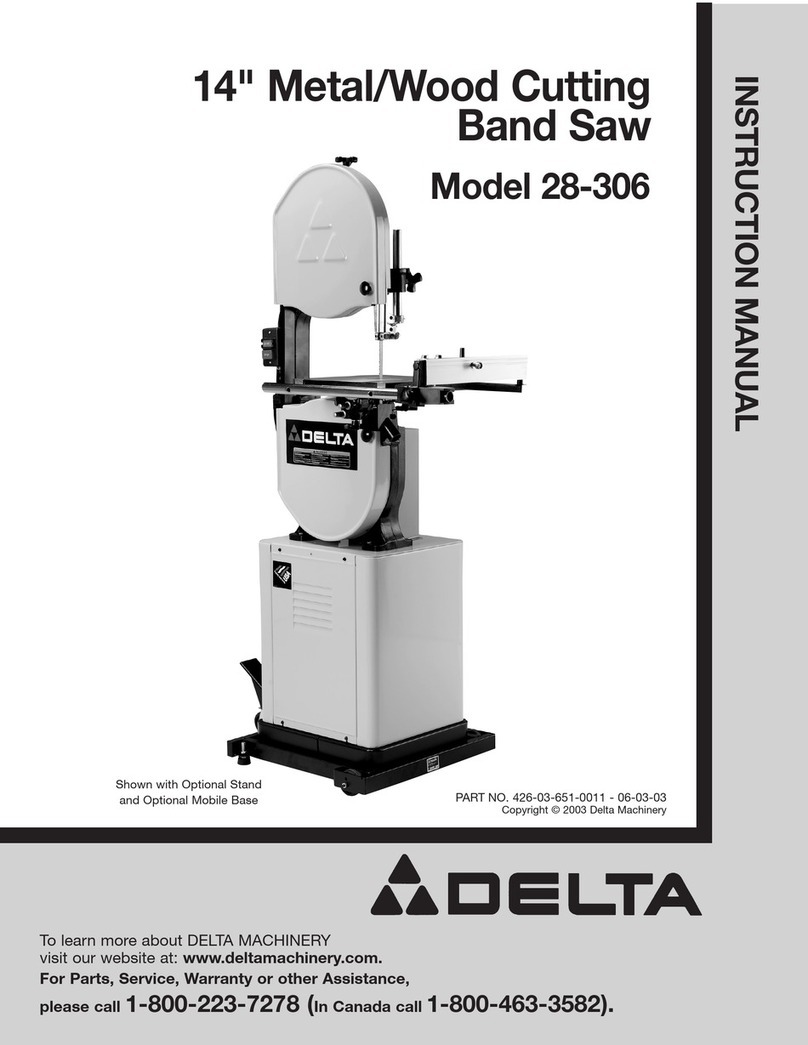
Delta
Delta 28-306 User manual
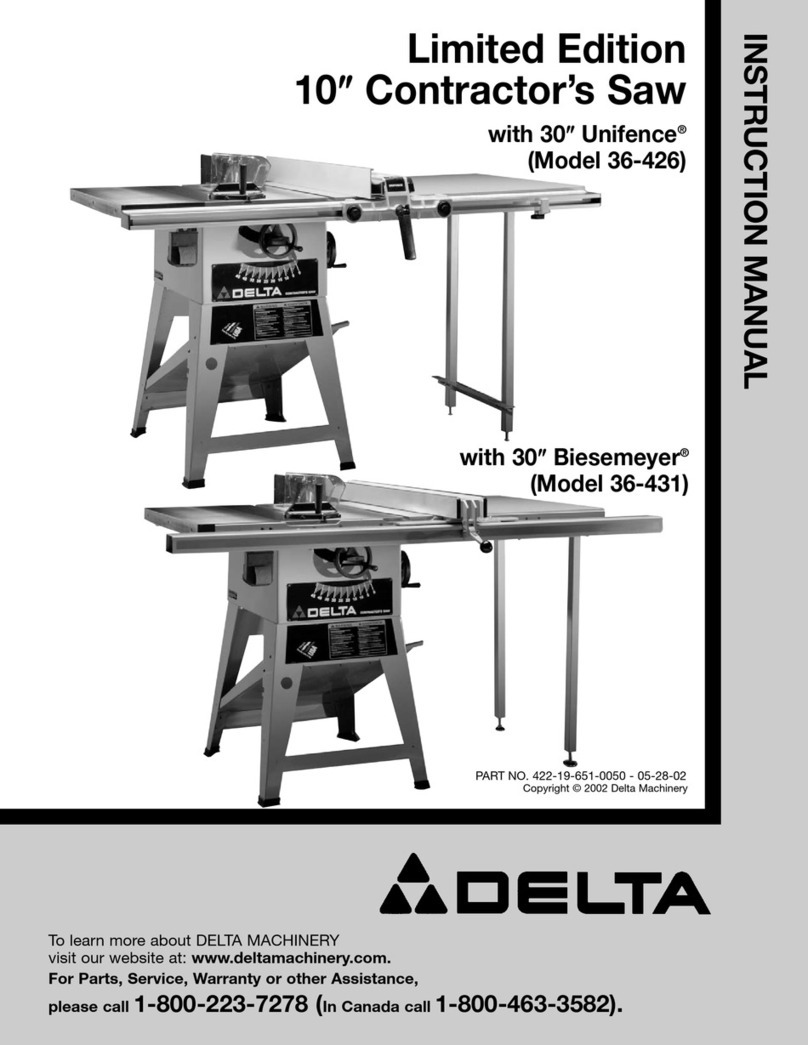
Delta
Delta 36-426 User manual
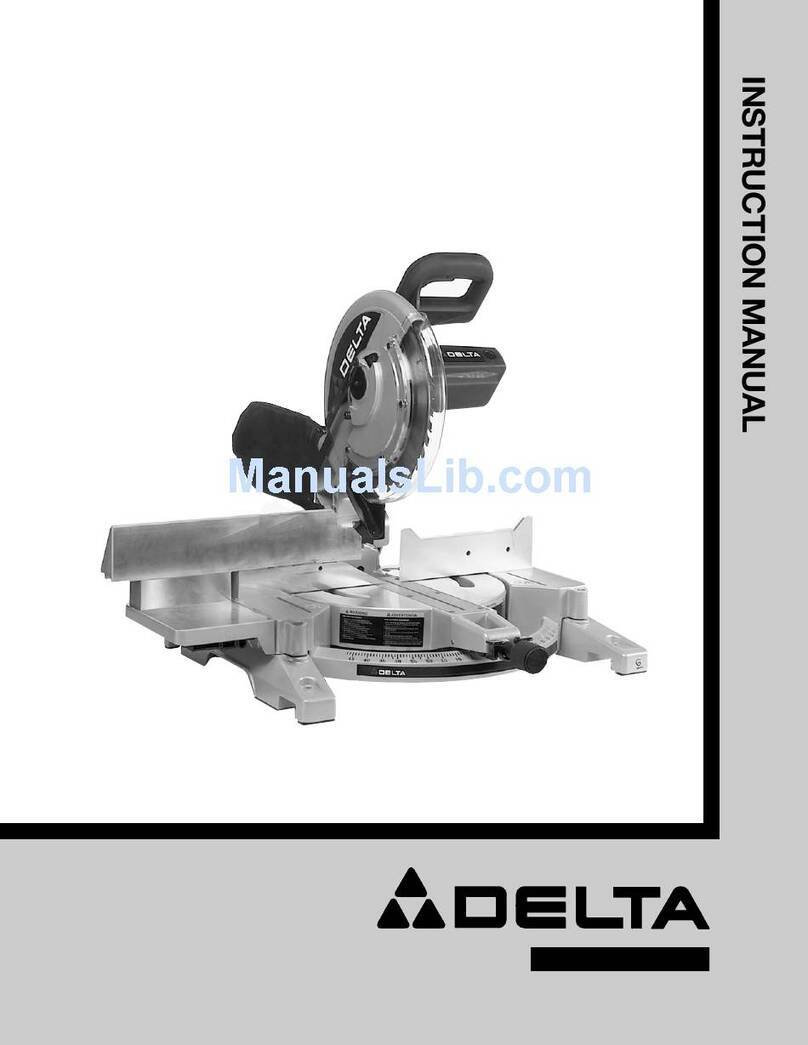
Delta
Delta 36-255 User manual
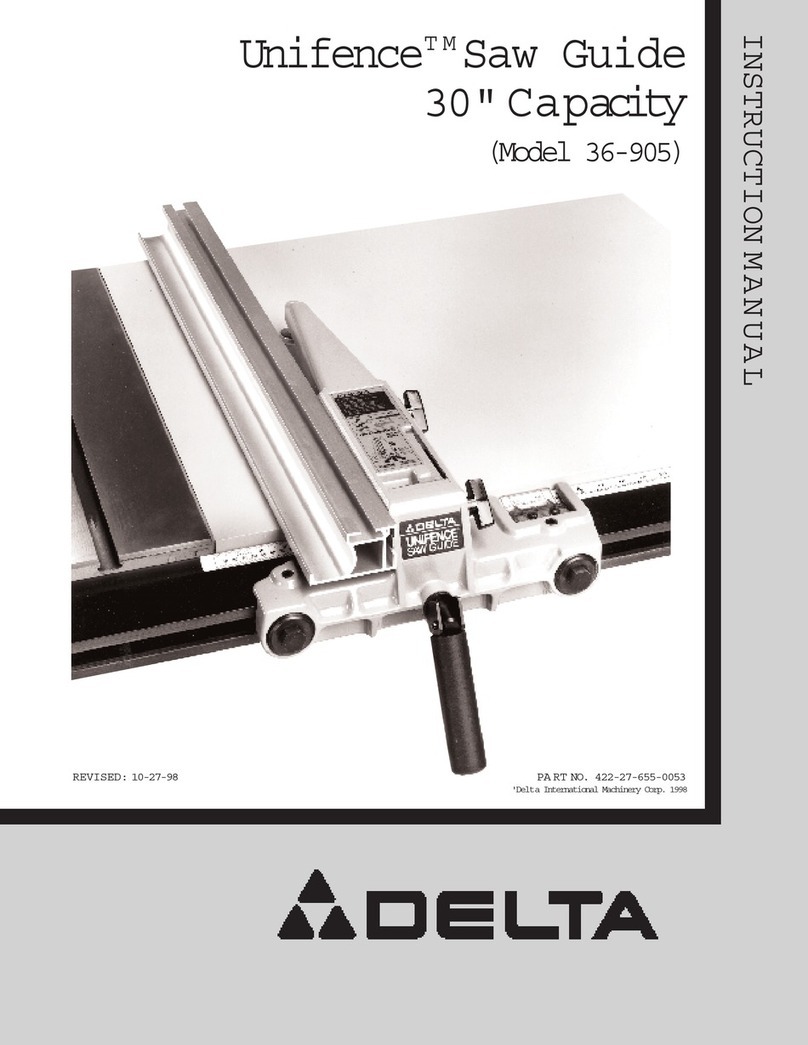
Delta
Delta Unifence 36-905 User manual

Delta
Delta 26-2240 User manual

Delta
Delta ShopMaster BS100 User manual
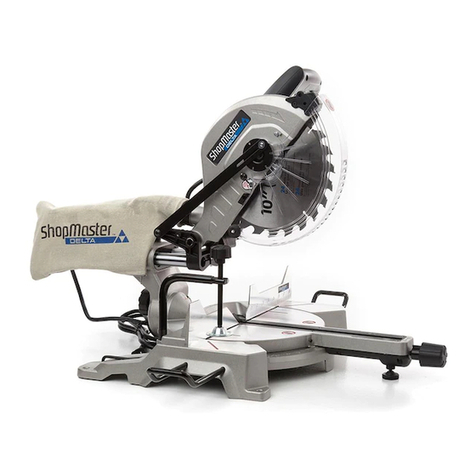
Delta
Delta ShopMaster S26-262LS User manual

Delta
Delta N028314 User manual
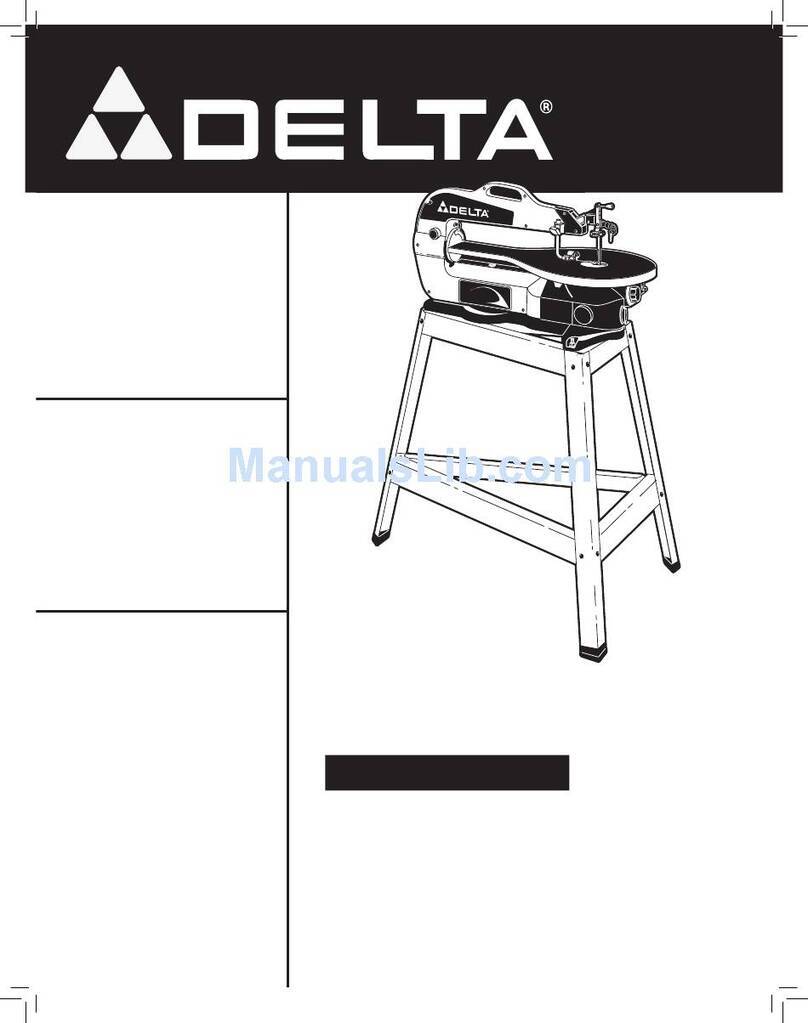
Delta
Delta SS350LS User manual
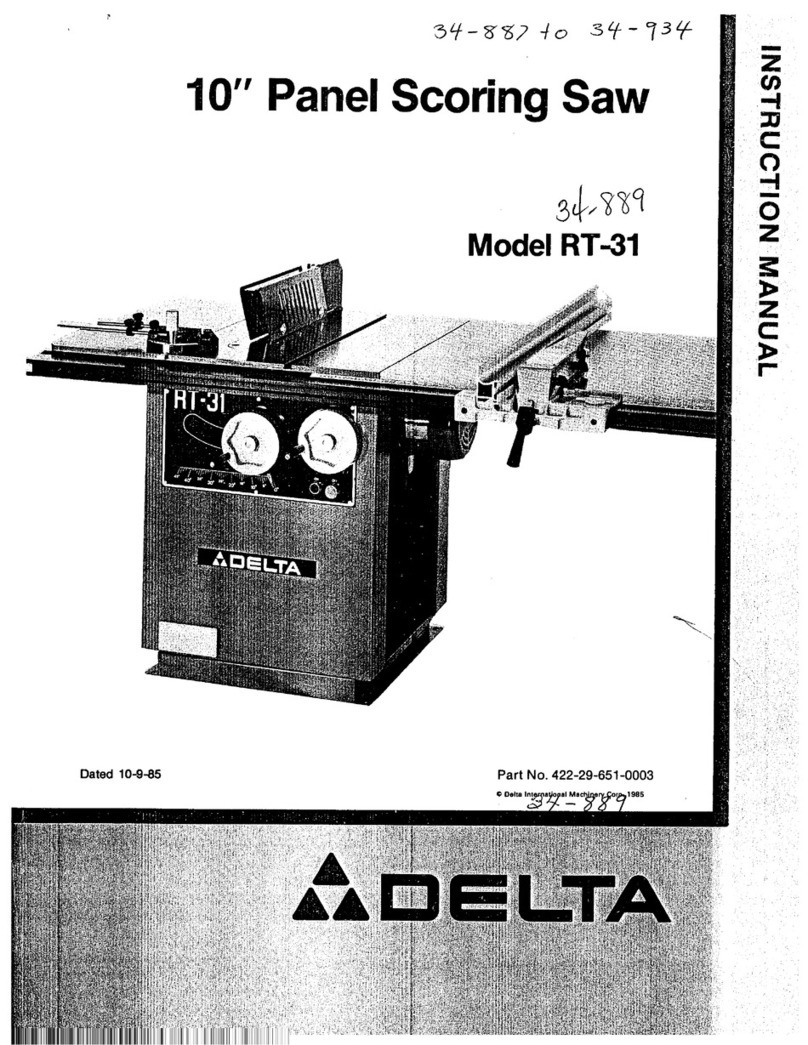
Delta
Delta RT-31 User manual
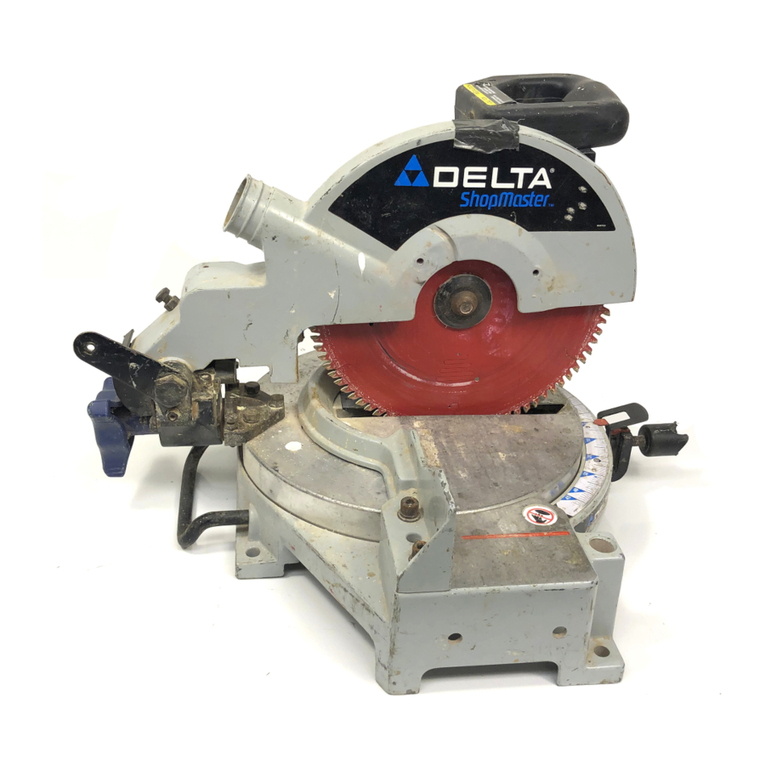
Delta
Delta ShopMaster MS250 User manual
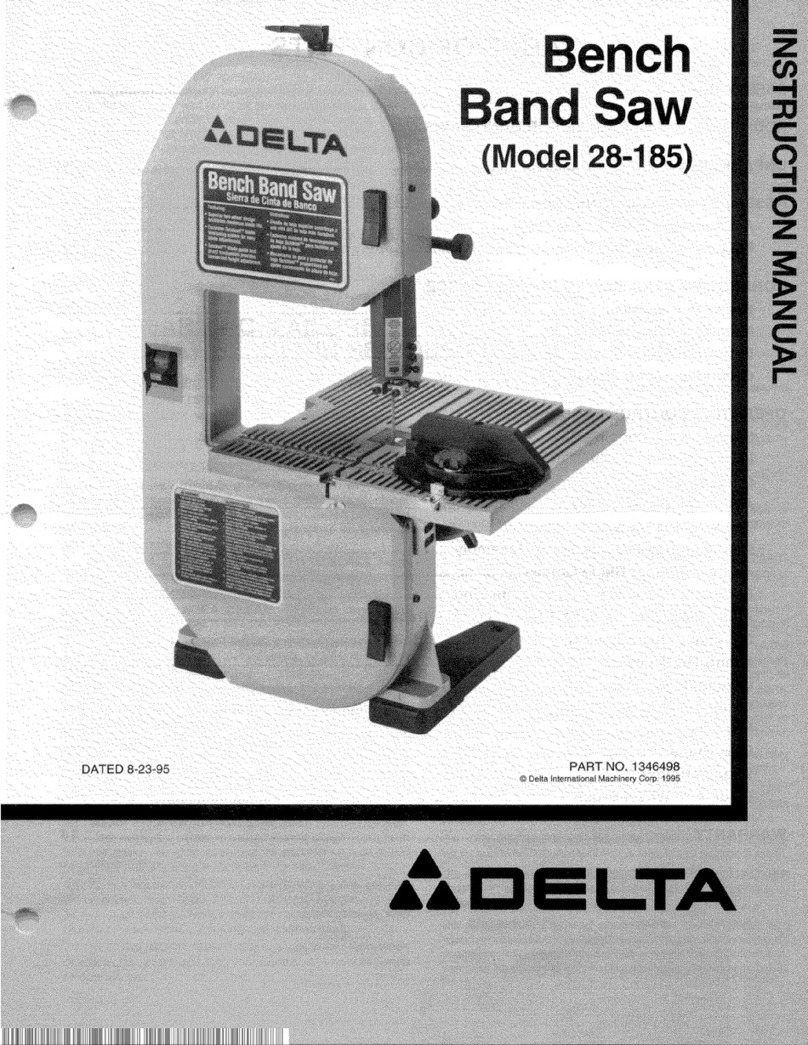
Delta
Delta 28-185 User manual
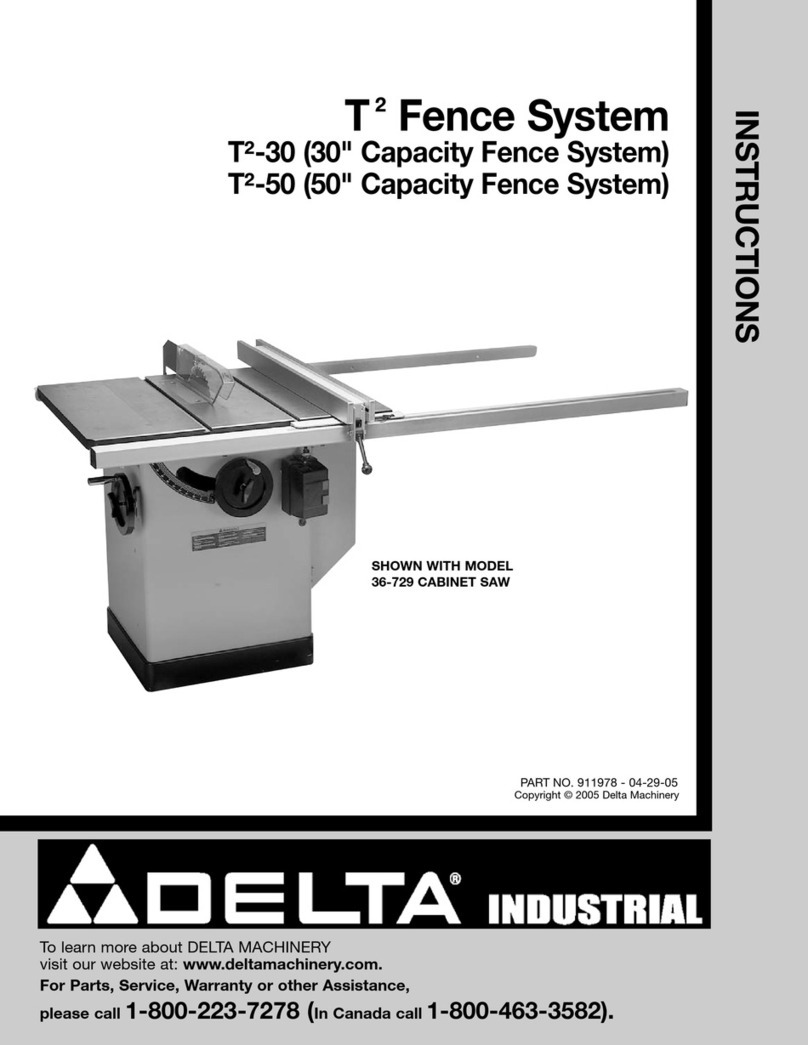
Delta
Delta T2-30 User manual

Delta
Delta 36-5000 User manual

Delta
Delta 36-510 Type II User manual
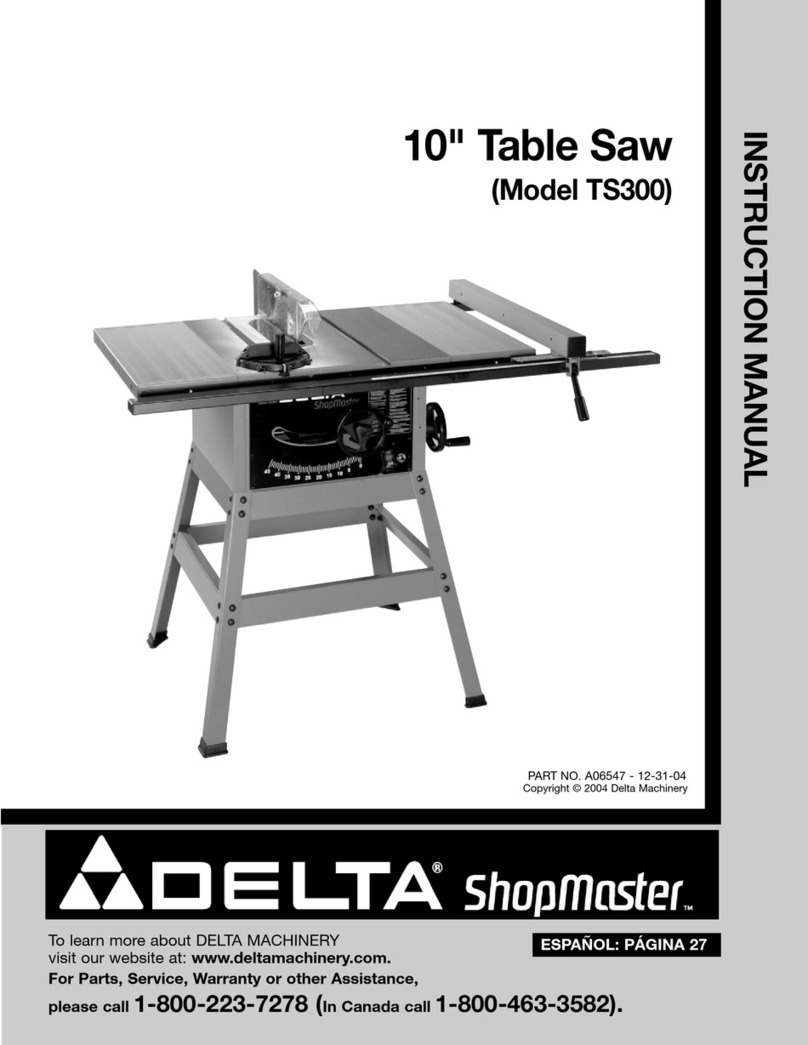
Delta
Delta ShopMaster TS300 User manual
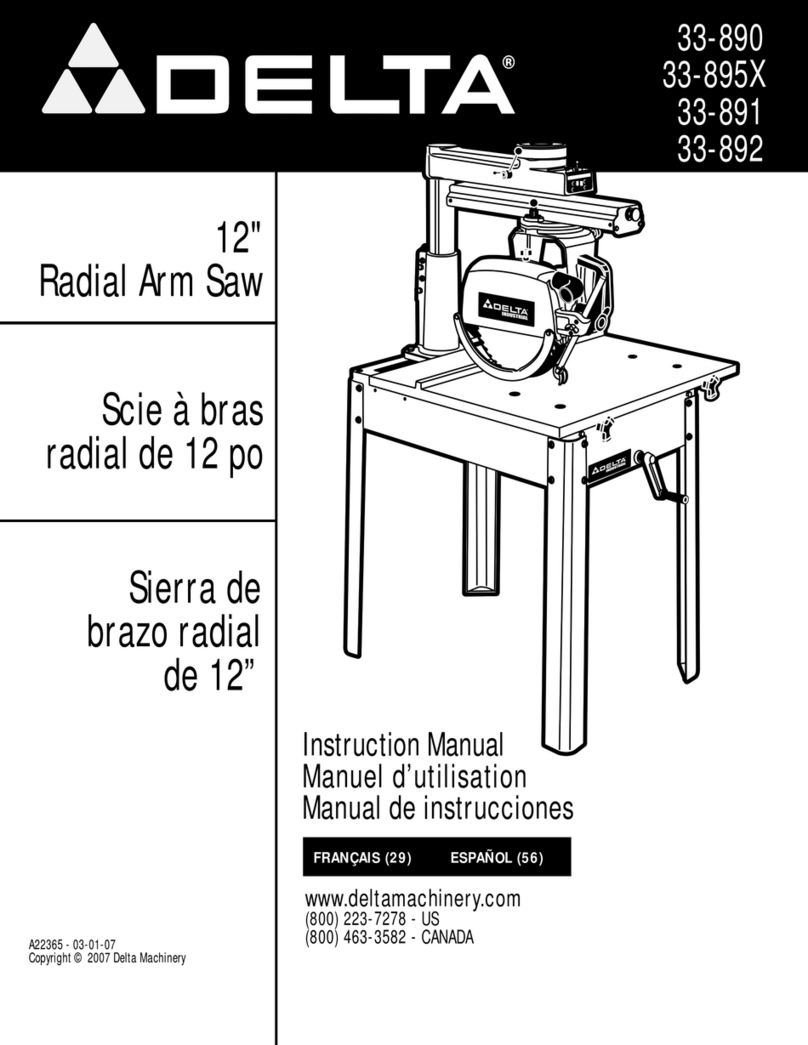
Delta
Delta 33-890 User manual
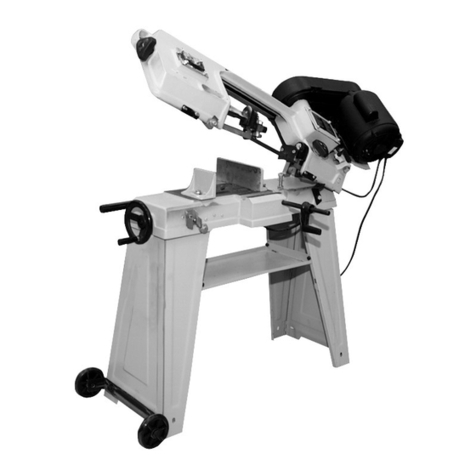
Delta
Delta 20-330 User manual
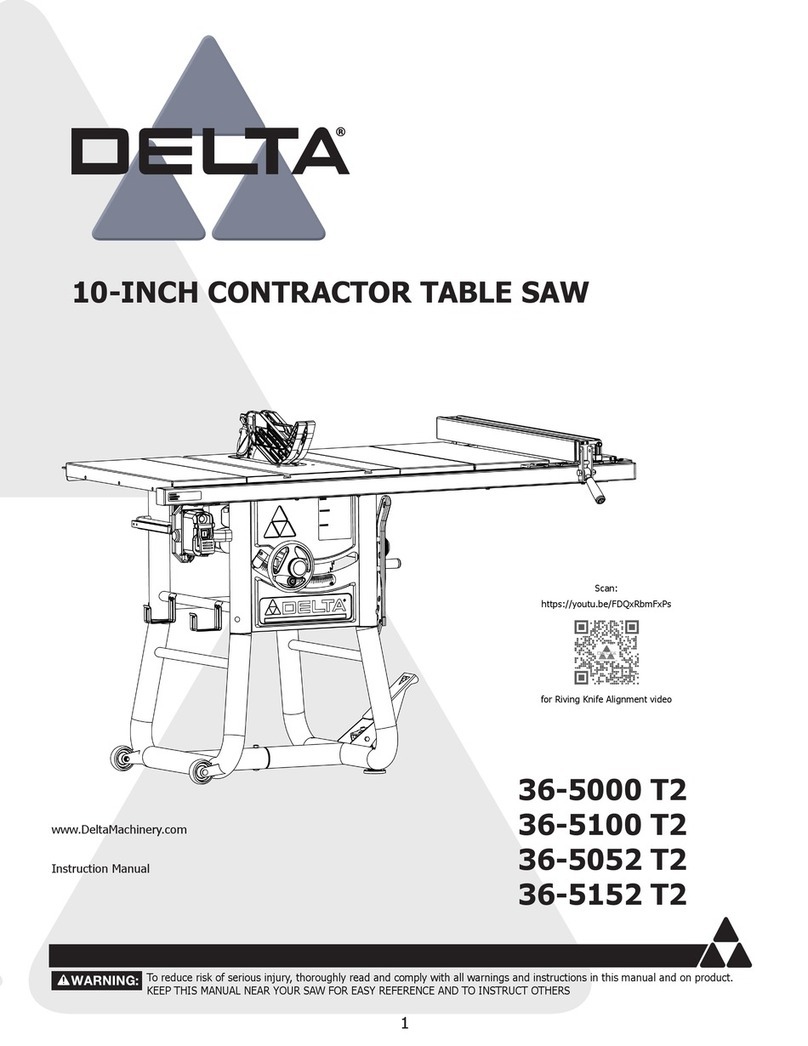
Delta
Delta 36-5100 T2 User manual

Delta
Delta 36-6023 User manual
